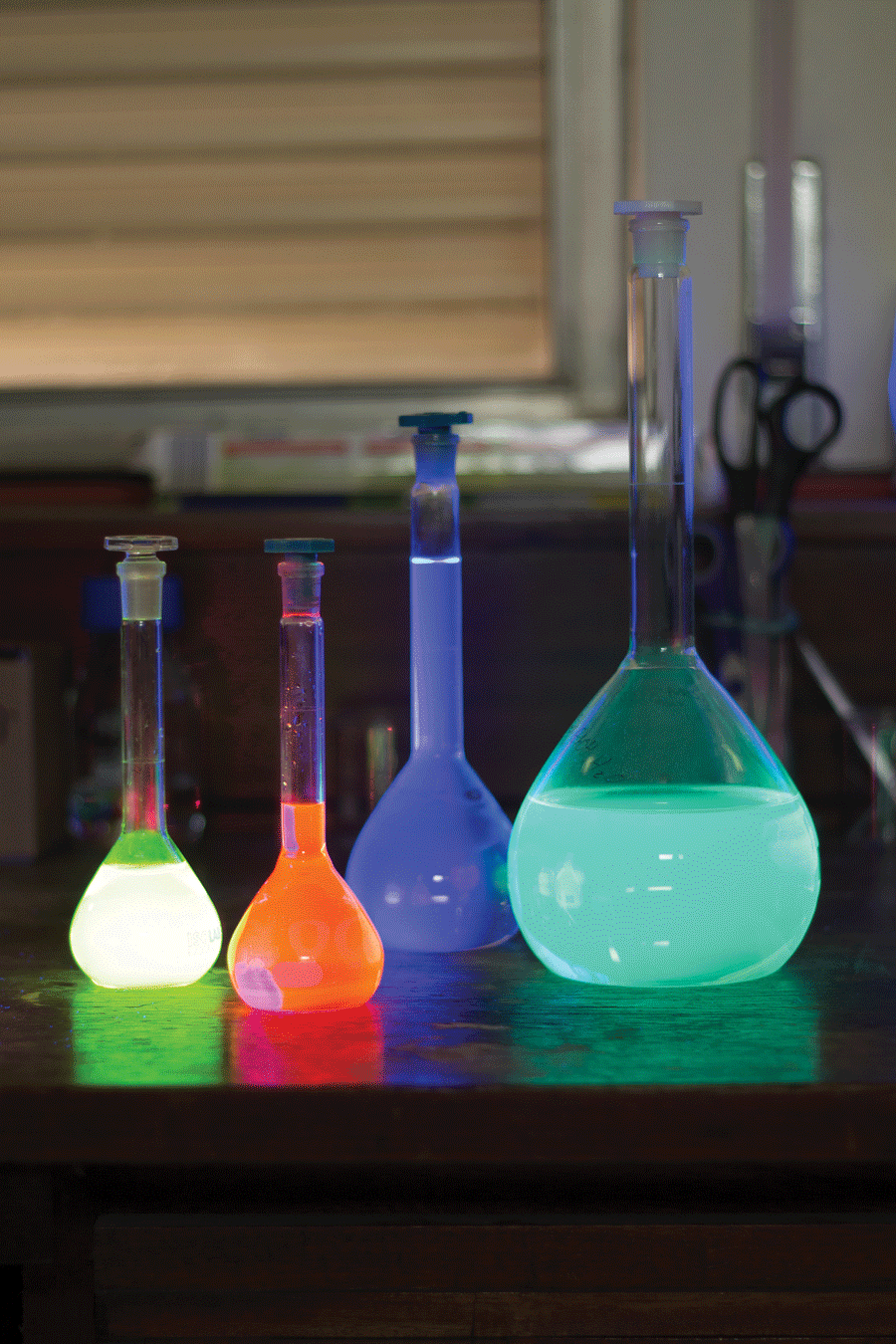Smart, logical, and colourful. Dr David Magri and his team develop intelligent molecules. They are not only smart because they perform logical functions, similar to computers, but because they can detect miniscule changes in their surroundings that causes them to emit a large array of colours. These colour changes are intriguing researchers and are a great benefit to society.
Colours fascinate Dr David Magri. He and his team create molecules that can detect biologically important chemicals and emit light. As molecular sensors they provide a simple and beautiful method with boundless applications from the detection of explosives in war zones to new medical and environmental diagnostic applications.
Some molecular sensors work by detecting a substance, or specific mixture of substances, and emitting light. They can work in a number of ways, but the underlying principle is that these molecules detect a substance, normally the presence of acids or toxins, that makes another part of the molecule sensitive to be powered by light. This second part can now adsorb UV light, which we do not really see, and emit coloured light, which we do. This coloured light can be seen by our eyes or some technology letting us know, for example, the levels of calcium in bones to find minuscule bone damage.
Captivating Colourful Chemistry
Colour is one of the world’s most captivating experiences. We often describe an intense day full of different experiences as being ‘a colourful day’. Different colours elicit unique emotions and experiences. However, colour is also a form of energy, a radiation, which can be interpreted as a form of data. Researchers are taking advantage of this property to detect and measure chemicals in the environment around us. Colour is central to these molecular sensors that have applications ranging from determining a swimming pool’s acidity or pH to measuring blood sodium levels.
Molecular sensors that exhibit colour are tiny, even smaller than a hair’s width, smaller than a living cell. They can go to places in our bodies that many other technologies cannot. These sensors can monitor parameters inside living organisms as they go about their daily activity. For example, in a cancer patient they could monitor specific protein levels in their blood stream without constant blood tests. Other medical conditions like diabetes could also be detected though a colourful display of fluorescent molecules.
“Colour is central to molecular sensors that have applications ranging from determining a swimming pool’s acidity or pH to measuring blood sodium levels”
These intelligent molecules are like ‘007 agents’, said Magri. They could go inside living systems unlike current semiconductor technologies. They are used as probes for environmental changes. Soils are commonly polluted around landfills. Molecular sensors can easily detect minuscule amounts of chemicals that have leaked. This warning signal would be a specific colour. The intensity of the colour would translate into the quantity of substance being detected. These sensors can detect mercury, cadmium, lead, and other toxins. A sensor can detect one molecule but they can become a lot more useful if they detect multiple chemical substances together.
Multiple substances, or inputs, can be detected using the concept of logic gates. Logic gates are a fundamental component of modern technologies such as computers and smartphones. But let us go back to basics: the light bulb. This is the simplest possible logic gate. It has two states: ‘off’ (called 0 in binary), with no light emitted, and ‘on’ (called 1 in binary) when you flick the switch. The simplest molecular sensors work in the same way. In the ‘off’ state they are colourless or dark, but on detecting a desired chemical, the molecule switches ‘on’ and either changes colour or glows brightly.
More sophisticated molecules can detect multiple substances, which act as the inputs. In the case of two-input logic gates two substances can be detected simultaneously. The most common examples are the AND gate and the OR gate. In an AND gate, if both switches are set to 1, the gate is switched on. When either switch, or both switches, are set to 0 the gate is switched off. An OR gate also has two inputs, but only needs one input to be switched on. To relate this to molecular sensors, molecules that can detect sodium and an acidic environment could be used to detect cancerous tissue.
| Colour |
|
Light travels in waves. Radio, microwaves, visible light, and X-rays are all waves of light. Colours are a small part of this spectrum. They vary in three properties: one is their wavelength—the distance from one wave to another. Colours can be defined by the different wavelengths they have, red having a longer wavelength and blue a shorter one, the colours of the rainbow spread in between. This works well for spectral colours but combinations of different wavelengths of light can also represent the same colours to our eyes (or more correctly, brain). So colour can be defined as light, and light is a form of energy, making colour a type of energy. Molecules can either emit light as a by-product of a chemical reaction releasing energy, or by adsorbing one wavelength of light and emitting another coloured light—these molecules are called fluorescent. Fluorescent molecules work by adsorbing light energy. Electrons circling around nuclei in atoms adsorb this energy. Adsorbing light makes the electron increase to higher energy levels, but also become unstable. The electron must return to the lower energy levels and when it does it emits light. |
Breaking Boundaries
Magri’s research team is developing molecules that work with water-based solutions rather than oily organic solvents that they typically work with. Maria Cardona, Magri’s graduate student, has been developing new water-soluble pH azobenzene dyes that are widely used in colouring perfumes, soaps, sweets, and food. The problem is that many of these dyes are toxic. Cardona modified one of these dyes by adding sulfonate groups to the molecule, which made it potentially much less harmful. These new molecules could be used to make safer food additives, keeping our food coloured without the harm.
Another student, Kristina Farrugia, is developing new molecular sensors to detect anions like fluoride—important for dental health. Her aim is to understand how these anions are detected. She is also trying to make them work in water-based envrionments to make them safer to use in humans.
Magri’s team has also created a new class of molecular sensor called a ‘Pourbaix sensor’. These sensors emit light when they detect acidic and oxidizing solutions. Oxidation is the process that turns iron into rust. The sensors are named in honour of Marcel Pourbaix, a French electrochemist, who studied the relationship between pH and oxidisation for many elements.
The research team has taken ‘Pourbaix sensors’ to the next stage by developing a prototype that detects three inputs. The molecular logic gate needs three inputs at the same time to light up. When only two, or fewer inputs are present, the molecule does not glow. When all three substances, or inputs, are present the molecule fluorescences and gives off a blue-coloured light. To operate successfully, the solution must contain high enough quantities of sodium, iron and protons (protons measure the acidity of a solution). When all of these substances are in a solution with the Pourbaix sensor, this sensor gives off a bright light.
The Pourbaix sensor is an example of the ‘lab-on-a-molecule’ idea, a molecule that gives a yes or no decision when it detects multiple substances and conditions. For example, high levels of sodium, iron, and pH can be linked to certain types of cancer. Molecules like the Pourbaix sensor can detect all of these things and light up, potentially identifying cancer in a person. Though it will take years, these molecules may be clinically useful in hospitals.
Revolution
The best thing about these molecules is their size. Used instead of other technologies, these molecules are so tiny that they can go where many other technologies cannot. Microchips cannot enter living cells, while molecular sensors are ideal for infiltrating cells and sending back information about the cell’s health. Examples of these sensors are used today in medical equipment to diagnose the blood analytes of patients. Since these molecules emit light that can easily be detected, researchers and medical practitioners only need to wait a few minutes for test results.
Molecular sensors could have a wide range of applications from disease detection to, perhaps, the creation of new brands of coloured sweets. Magri and his team have a long and colourful road ahead of them which will be filled with pockets of vibrant surprises.
The Research is funded by the Strategic Educational Pathways Scholarship (Malta). This Scholarship is part-financed by the European Union-European Social Fund (ESF) under Operational Programme II- Cohesion Policy 2007–2013, “Empowering People for More Jobs and a Better Quality of Life”. Financial support is also acknowledged from Cooperative in Science and Technology (COST) through the Action CM1005 “Supramolecular Chemistry in Water”.
Find out more:
-
Cardona, M. and Magri, D. C. Tetrahedron Letters, 2014, 55, 4559-4563. doi.org/10.1016/j.tetlet.2014.06.079.
-
Magri, D. C., Camilleri Fava, M. and Mallia, C. J. Chemical Communications 2014, 50, 1009-1011. doi:10.1039/C3CC48075E.
-
Cardona, M., Farrugia, K., Magri, D. C. ‘Medical Diagnostics with Designed Molecules with Sense and Logic’ Xjenza Online, 2013, 13, 34-41.






Comments are closed for this article!